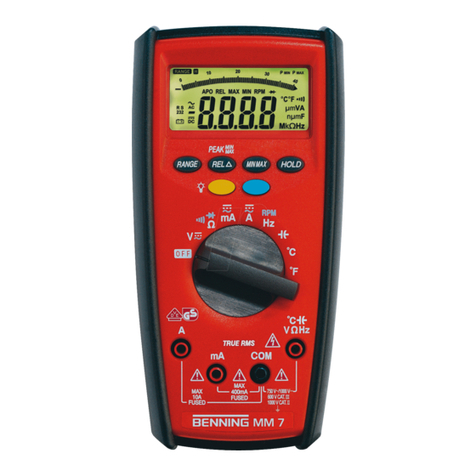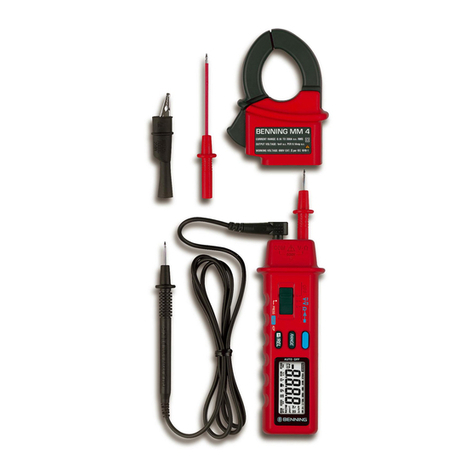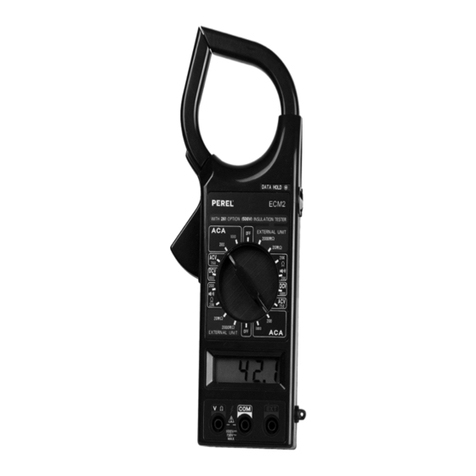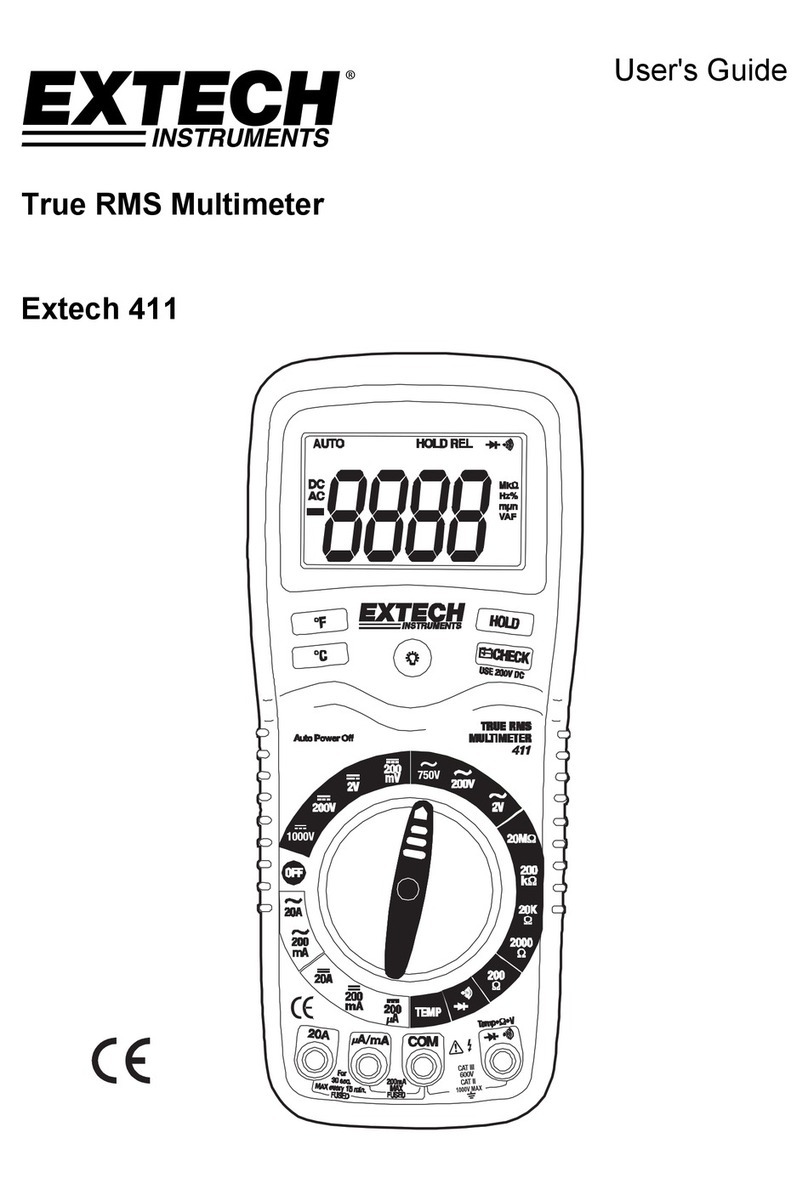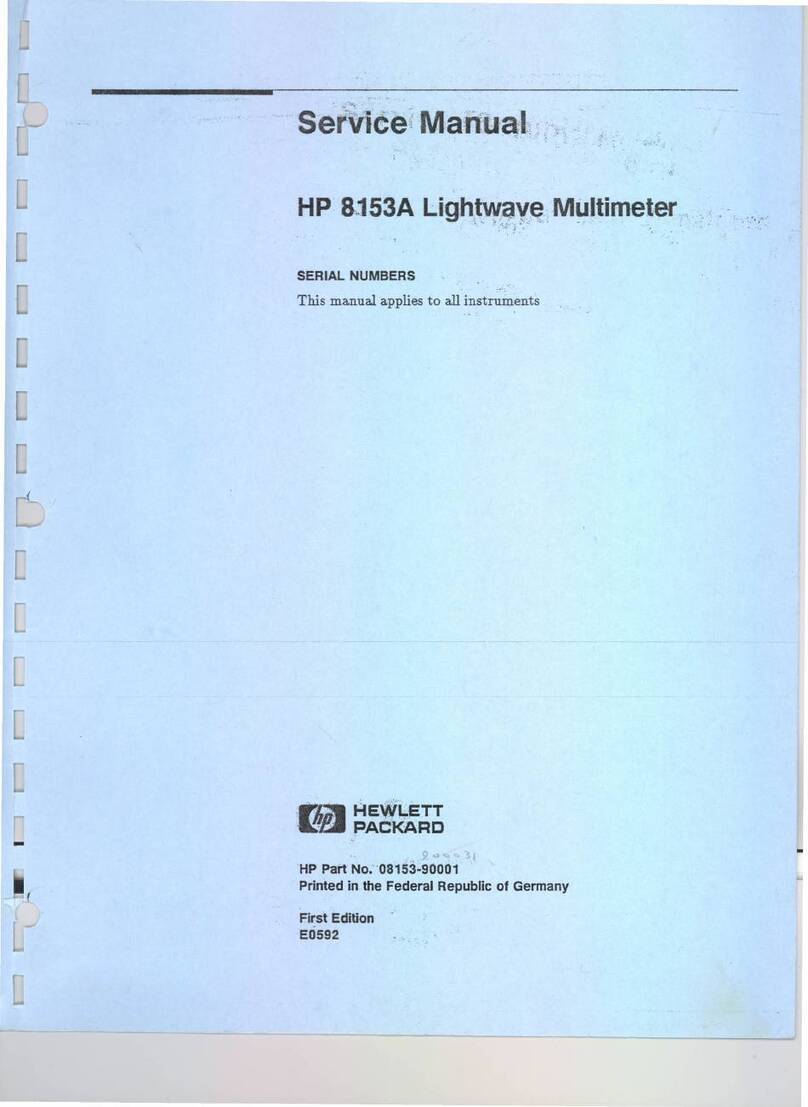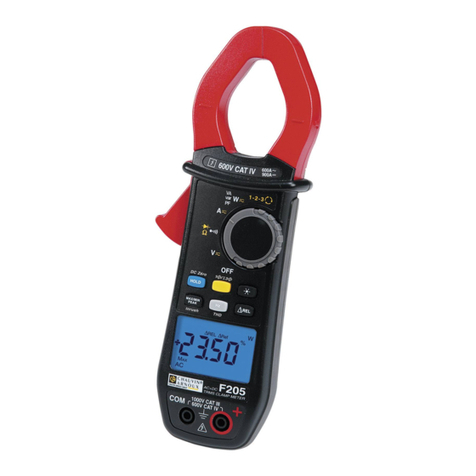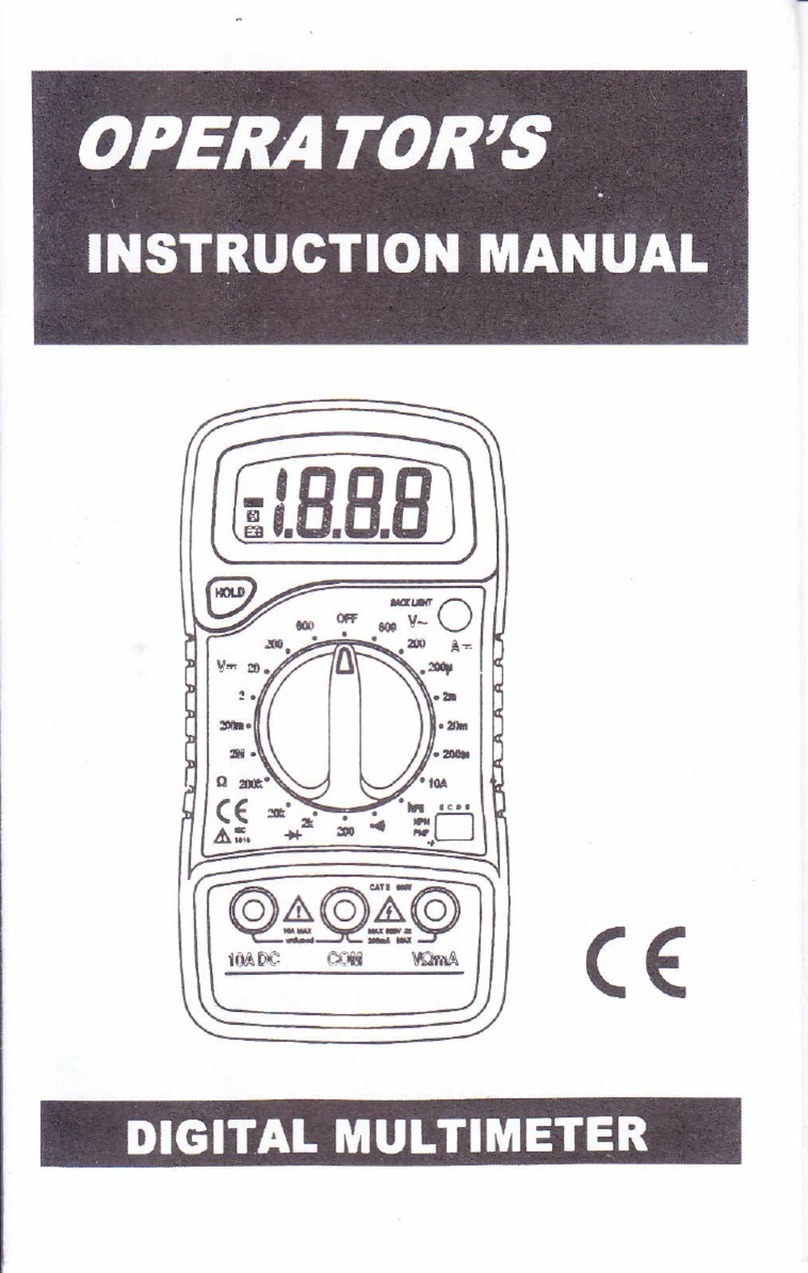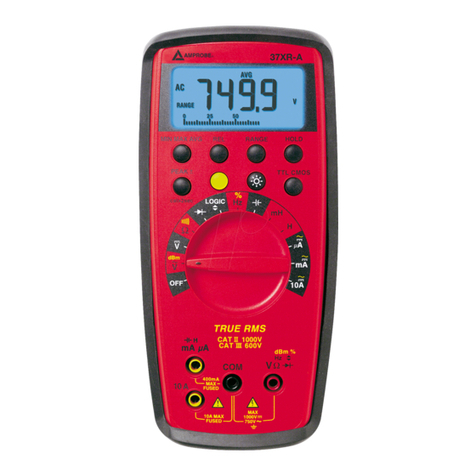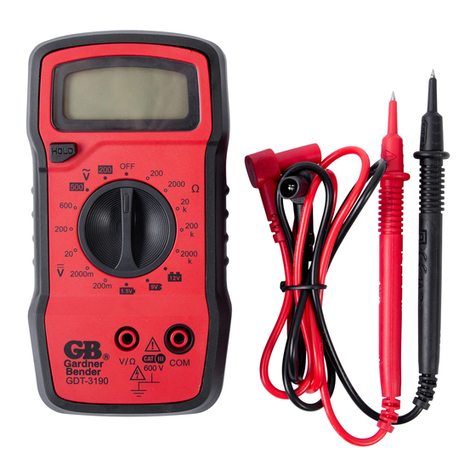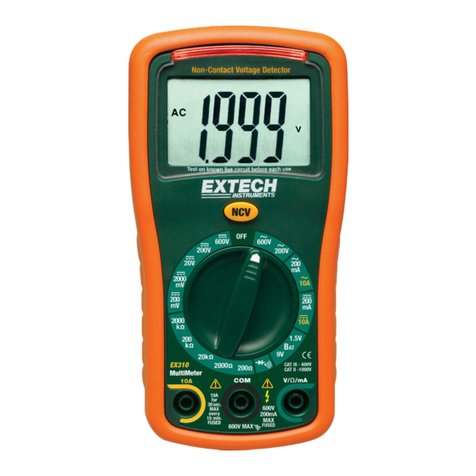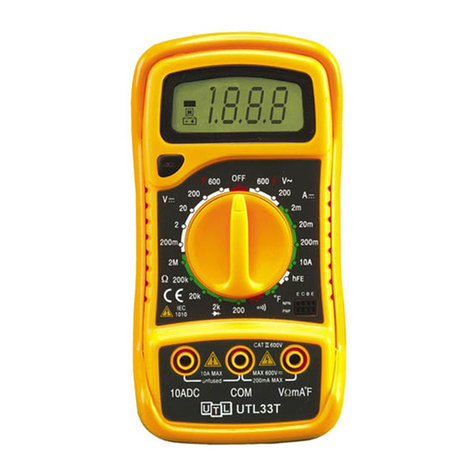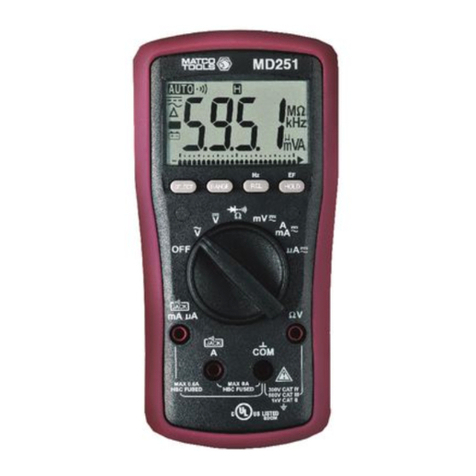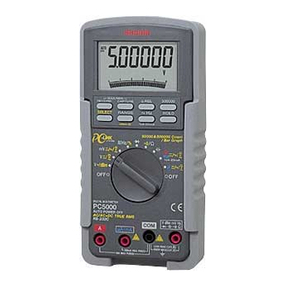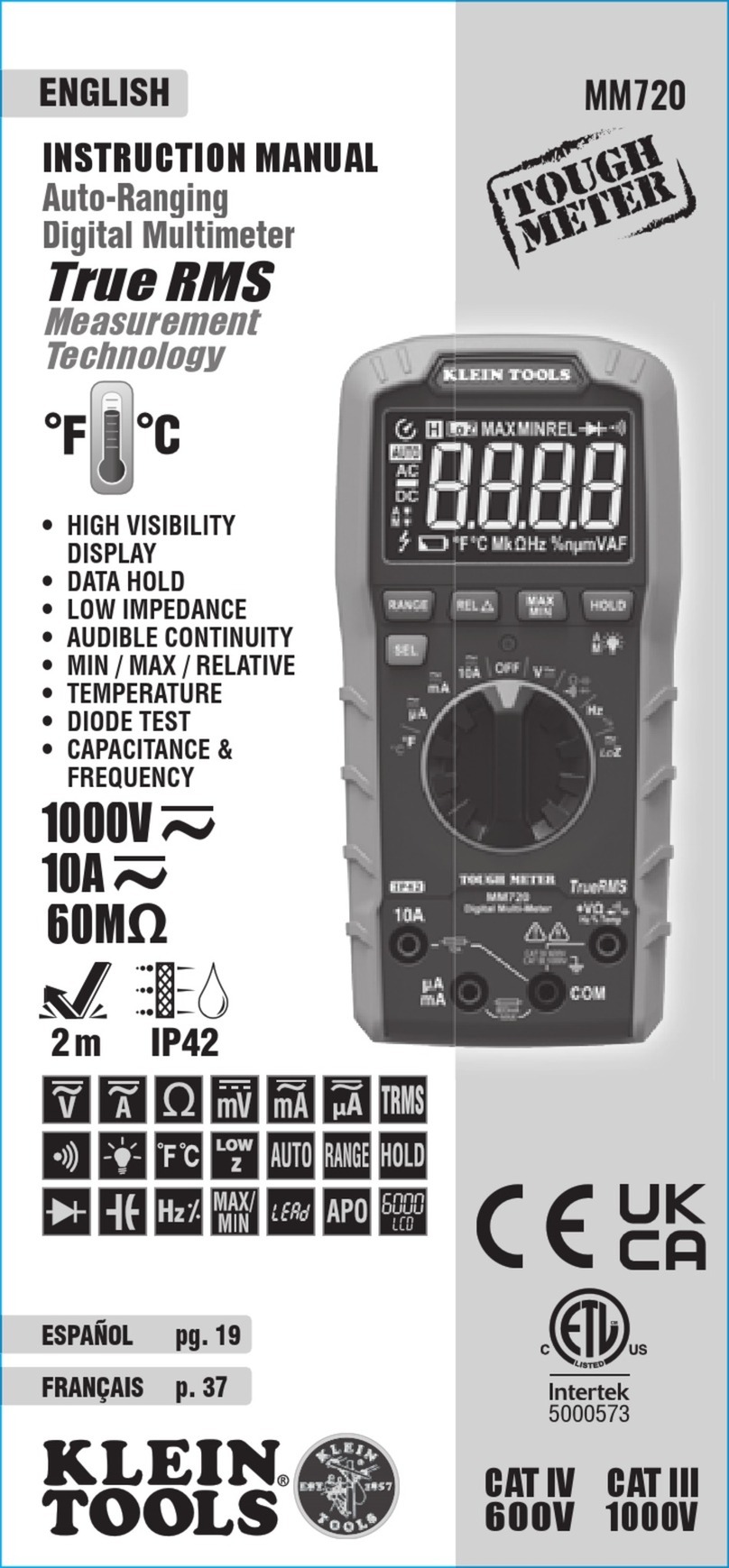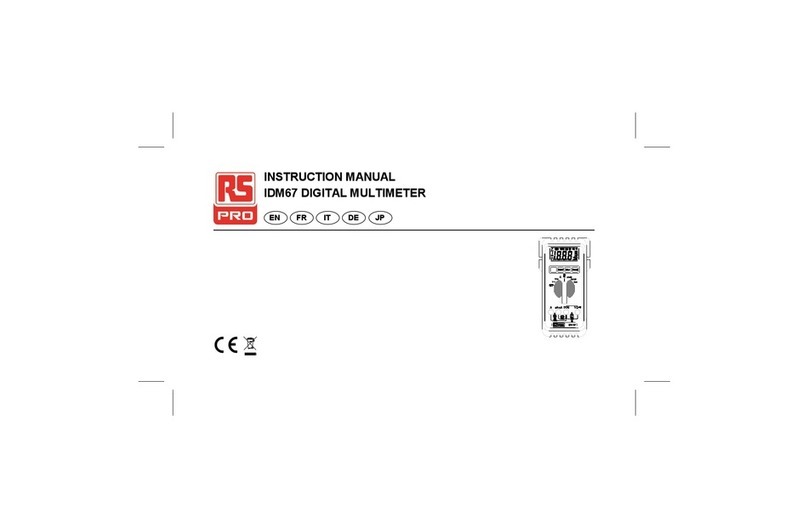Benning MM 1 User manual

DBedienungsanleitung
Operating manual
FNotice d‘emploi
EInstrucciones de servicio
Návod k obsluze
Οδηγίεςχρήσεως
IIstruzioni d’uso
Gebruiksaanwijzing
Instrukcjaobsługi
Instructiuni de folosire
Инструкцияпоэксплуатации
индикаторанапряжения
SBruksanvisning
Kullanma Talimati
BENNING MM 1

08/ 2008
BENNING MM 1
D
F E I S
Bild 1: Gerätefrontseite
Fig. 1: Front tester panel
Fig. 1: Panneau avant de l'appareil
Fig. 1: Parte frontal del equipo
Obr.1: Přední strana přístroje
σχήμα 1: Μπροστινή όψη
ill. 1: Lato anteriore apparecchio
Fig. 1: Voorzijde van het apparaat
Rys.1: Panel przedni przyrządu
Imaginea 1: Partea frontală a aparatului
Рис. 1. Фронтальная сторона прибора
Fig. 1: Framsida
Resim 1: Cihaz önyüzü

08/ 2008
BENNING MM 1
D
F E I S
Bild 2: Gleichspannungsmessung
Fig. 2: Direct voltage measurement
Fig. 2: Mesure de tension continue
Fig. 2: Medición de corriente contínua
Obr.2: Měření stejnosměrného napětí
σχήμα 2: μέτρηση DC-τάσης
ill. 2: Misura tensione continua
Fig. 2: Meten van gelijkspanning
Rys.2: Pomiar napięcia stałego
Imaginea 2: Măsurarea tensiunii continue
Рис. 2. Измерение напряжения
постоянного тока
Fig. 2: Likspänningsmätning
Resim 2: Doğru Gerilim Ölçümü
Bild 3: Wechselspannungsmessung
Fig. 3: Alternating voltage measurement
Fig. 3: Mesure de tension alternative
Fig. 3: Medición de tensión alterna
Obr.3: Měření střídavého napětí
σχήμα 3: μέτρηση AC-τάσης
ill. 3: Misura tensione alternata
Fig. 3: Meten van wisselspanning
Rys.3: Pomiar napięcia przemiennego
Imaginea 3: Măsurarea tensiunii alternative
Рис. 3. Измерение напряжения
переменного тока
Fig. 3: Växelspänningsmätning
Resim 3: Alternatif Gerilim Ölçümü
Bild 4: Gleichstrommessung
Fig. 4: DC current measurement
Fig. 4: Mesure de currant continu
Fig. 4: Medición de corriente continua
Obr.4: Měření stejnosměrného proudu
ill. 4: Misura corrente continua
σχήμα 4: μέτρηση συνεχούς ρεύματος
Fig. 4: Meten van gelijkstroom
Rys.4: Pomiar prądu stałego
Imaginea 4: Măsurarea curentului continuu
Рис. 4. Измерение постоянного тока
Fig. 4: Likströmsmätning
Resim 4: Doğru Akım Ölçümü

08/ 2008
BENNING MM 1
D
F E I S
Bild 6: Durchgangsprüfung mit Summer
Fig. 6: Continuity Testing with buzzer
Fig. 6: Contrôle de continuité avec ronfleur
Fig. 6: Control de continuidad con vibrador
σχήμα 6: Έλεγχος συνέχειας με ηχητικό
σήμα
ill. 6: Prova di continuità con cicalino
Obr. 6: Zkouška průchodu bzučákem
Fig. 6: Doorgangstest met akoestisch
signaal
Rys.6: Sprawdzenie ciągłości obwodu
Imaginea 6: Măsurarea continuităţii cu buzzer
Рис. 6. Проверка целостности
цепи (прозвонка)
Fig. 6: Genomgångstest med summer
Resim 6: Sesli Süreklilik Ölçümü
Bild 7: Diodenprüfung
Fig. 7: Diode Testing
Fig. 7: Contrôle de diodes
Fig. 7: Verificación de diodos
Obr.7: Měření diod
σχήμα 7: Έλεγχος διόδου
ill. 7: Prova diodi
Fig. 7: Diodecontrole
Rys.7: Pomiar diody
Imaginea 7: Măsurarea diodelor
Рис. 7. Проверка диодов
Fig. 7: Diod-test
Resim 7: Diyot Ölçümü
Bild 5: Widerstandsmessung
Fig. 5: Resistance measurement
Fig. 5: Mesure de résistance
Fig. 5: Medición de resistencia
Obr.5: Měření odporu
σχήμα 5: Μέτρηση αντίστασης
ill. 5: Misura di resistenza
Fig. 5: Weerstandsmeting
Rys.5: Pomiar rezystancji
Imaginea 5: Măsurarea rezistenţei
Рис. 5. Измерение сопротивления
Fig. 5: Resistansmätning
Resim 5: Direnç Ölçümü

08/ 2008
BENNING MM 1
D
F E I S
Bild 10: Gummi-Schutzrahmen inkl. frei stehender
Messspitze
Fig. 10:
Protective rubber holster with one probe free
for single handed operation
Fig. 10: Cadre de protection en caoutchouc avec
pointe de mesure libre
Fig. 10: Marco protector de goma, con punta de
medición libre
Obr.10:
Pryžový rám přístroje včetně volných měřících
hrotů
σχήμα 10:
Προστατευτικό κάλυμμα με ελεύθερο άκρο
μέτρησης
ill. 10: Guscio protettivo con puntale di misura
libero
Fig .10: Beschermingshoes
Rys.10: Gumowy futerał ochronny z jedną
końcówką swobodną do obsługi
jednoręcznej
Imaginea 10:
Ramă de protecţie din cauciuc
Рис. 10. Установка измерительного провода в
клипсу
Fig. 10: Gummiskyddsram
Res.10: Boşta duran ölçüm ucu dahil Lastik
koruyucu çerçeve
Bild 9: Aufwicklung der Sicherheits mess leitungen
am Gummi-Schutz rahmen
Fig. 9: Wrapping up the safety test leads
Fig. 9: Enroulement des câbles de mesure de
sécurité sur le cadre de protec tion en
caoutchouc
Fig. 9: Arrollamiento de las conducciones
protegidas de medición en el marco
protector de goma
Obr.9: Navinutí měřících vodičů na pryžový rám
přístroje
σχήμα 9: Τυλίξτε τα καλώδια μέτρησης γύρω από το
προστατευτικό κάλυμμα
ill. 9: Avvolgimento dei cavetti di sicurezza
intorno al guscio protettivo
Fig. 9: Wikkeling van veiligheidsmeetsnoeren
Rys.9: Zwijanie przewodów pomiarowych
Imaginea 9: Înfăşurarea firelor de măsurare pe rama
din cauciuc
Рис. 9 Намотка измерительного провода
Fig. 9: Placering av säkerhetsmätsladdar
Resim 9: Emniyet Ölçüm Tesisatının Lastik
çerçeveye Sarılması
Bild 8: Batteriewechsel
Fig. 8: Battery replacement
Fig. 8: Remplacement de la pile
Fig. 8: Cambio de batería
Obr. 8: Výměna baterií
σχήμα 8: Αντικατάσταση μπαταριών
ill. 8: Sostituzione batterie
Fig. 8: Vervanging van de batterijen
Rys.8: Wymiana baterii
Imaginea 8:Schimbarea bateriei
Рис. 8. Замена батарейки
Fig. 8: Batteribyte
Resim 8: Batarya Değişimi

08/ 2008
BENNING MM 1
D
F E I S
Bild 11: Aufstellung des BENNING MM 1
Fig. 11: Standing up the BENNING MM 1
Fig. 11: Installation du BENNING MM 1
Fig. 11: Colocación del BENNING MM 1
Obr.11: Postavení přístroje BENNING MM 1
σχήμα11: Κρατώντας όρθιο το BENNING MM 1
ill. 11: Posizionamento del BENNING MM 1
Fig. 11: Opstelling van de multimeter
Rys.11: Przyrząd BENNING MM1 w pozycji
stojącej
Imaginea 11:
Poziţionarea pe verticală a aparatului
BENNING MM 1
Рис. 11 Установка прибора BENNING MM 1
Fig. 11: Instrumentstöd
Res.11: BENNING MM 1’in kurulumu

08/ 2008
BENNING MM 1
1
D
Bedienungsanleitung
BENNING MM 1
Digital-Multimeter zur
- Wechselspannungsmessung
- Gleichspannungsmessung
- Gleichstrommessung
- Widerstandsmessung
- Durchgangsprüfung
- Diodenprüfung
Inhaltsverzeichnis
1. Benutzerhinweise
2. Sicherheitshinweise
3. Lieferumfang
4. Gerätebeschreibung
5. Allgemeine Angaben
6. Umgebungsbedingungen
7. Elektrische Angaben
8. Messen mit dem BENNING MM 1
9. Instandhaltung
10. Anwendung des Gummi-Schutzrahmens
11. Technische Daten des Messzubehörs
12. Umweltschutz
1. Benutzerhinweise
Diese Bedienungsanleitung richtet sich an
- Elektrofachkräfte und
- elektrotechnisch unterwiesene Personen
Das BENNING MM 1 ist zur Messung in trockener Umgebung vorgesehen
und darf nicht in Stromkreisen mit einer höheren Nennspannung als 600 V AC
oder DC eingesetzt werden (Näheres hierzu im Abschnitt 6. "Umgebungsbe-
dingungen").
In der Bedienungsanleitung und auf dem BENNING MM 1 werden folgende
Symbole verwendet:
Dieses Symbol weist auf elektrische Gefahr hin.
Dieses Symbol weist auf Gefährdungen beim Gebrauch des
BENNING MM 1 hin. (Dokumentation beachten!)
Dieses Symbol auf dem BENNING MM 1 bedeutet, dass das Gerät
schutzisoliert (Schutzklasse II) ausgeführt ist.
Dieses Symbol erscheint in der Anzeige für eine entladene
Batterie.
Dieses Symbol kennzeichnet den Bereich “Durchgangsprüfung”.Der
Summer dient der akustischen Ergebnisausgabe.
Dieses Symbol kennzeichnet den Bereich „Diodenprüfung“.
(DC) Gleichspannung.
(AC) Wechsel- Spannung oder Strom.
Masse (Spannung gegen Erde).

08/ 2008
BENNING MM 1
2
D
2. Sicherheitshinweise
Beispiel für Sicherheitshinweis:
Elektrische Gefahr!
Beachten Sie die Sicherheitshinweise!
Bevor Sie das BENNING MM 1 benutzen, lesen Sie bitte die Bedienungsanleitung
sorgfältig. Beachten Sie die Sicherheitshinweise in der Bedienungsanleitung.
Damit schützen Sie sich vor Unfällen und das BENNING MM 1 vor Schaden.
3. Lieferumfang
Zum Lieferumfang des BENNING MM 1 gehören:
3.1 ein Stück BENNING MM 1,
3.2 ein Stück Sicherheitsmessleitung, rot (L = 1,4 m; Spitze Ø = 4 mm) mit
Schutzkappen,
3.3 ein Stück Sicherheitsmessleitung, schwarz (L = 1,4 m; Spitze Ø = 4 mm)
mit Schutzkappen,
3.4 ein Stück Gummi-Schutzrahmen,
3.5 ein Stück Kompakt-Schutztasche,
3.6 zwei 1,5-V-Micro-Batterien (zur Erstbestückung im Gerät eingebaut),
3.7 die Bedienungsanleitung.
Hinweis auf Verschleißteile:
Das BENNING MM 1 wird von zwei 1,5-V-Micro-Batterien (2x1,5-V-IEC LR03)
gespeist.
4. Gerätebeschreibung
siehe Bild 1: Gerätefrontseite
Die in Bild 1 angegebenen Anzeige- und Bedienelemente werden wie folgt
bezeichnet:
Digitalanzeige für den Messwert, Bargraphanzeige, Anzeige der
Bereichsüberschreitung
Polaritätsanzeige,
Batterieanzeige, erscheint bei entladener Batterie,
Drehschalter, für Wahl der Funktion,
Buchse (positive1) für V, Ω, µA, ,
COM-Buchse, gemeinsame Buchse für Spannungs-, Widerstandsmes-
sungen, Durchgangs- und Diodenprüfung,
RANGE-Taste,
HOLD-Taste,
Gummi-Schutzrahmen
1 ) Hierauf bezieht sich die automatische Polaritätsanzeige für Gleichspannung
5. Allgemeine Angaben
5.1 Allgemeine Angaben zum BENNING MM 1
5.1.1
Die Digitalanzeige ist als 3½-stellige Flüssigkristallanzeige mit 10,5 mm
Schrifthöhe mit Dezimalpunkt ausgeführt. Der größte Anzeigewert ist 3200
.
5.1.2 Die Polaritätsanzeige wirkt automatisch. Es wird nur eine Polung
entgegen der Buchsendefinition mit "-" angezeigt.
5.1.3 Die Bereichsüberschreitung wird mit blinkender "1" oder "-1" angezeigt
und der Summer ertönt.
5.1.4
Bereichstaste "RANGE" dient zur Weiterschaltung der manuellen Mess-
bereiche, bei gleichzeitiger Einblendung "RANGE" im Display. Durch länge-
ren Tastendruck (2 Sekunden) wird die automatische Bereichswahl gewählt
(Anzeige "RANGE" erlischt). In der Drehschalterposition ,ermög-
licht die Bereichstaste "RANGE" ein Wechseln zwischen der Funktion
Durchgangsprüfung und der Funktion Diodenprüfung.
5.1.5 Messwertspeicherung (Hold), durch Betätigen der Taste "HOLD"
lässt sich das Messergebnis speichern. Im Display wird gleichzeitig das
Symbol "H" eingeblendet. Erneutes Betätigen schaltet in den Mess-
modus zurück.
5.1.6 Die Messrate der Ziffernanzeige des BENNING MM 1 beträgt nominal
ca. 2 Messungen pro Sekunde. Die Messrate der Bargraphanzeige
beträgt ca. 12 Messungen pro Sekunde.
5.1.7 Das BENNING MM 1 wird durch den Drehschalter ein- oder ausge-
schaltet. Ausschaltstellung "OFF".
5.1.8. Das BENNING MM 1 schaltet nach ca. 10 min. selbsttätig ab. Er schal-
tet wieder ein, wenn die "RANGE"-Taste betätigt wird.
5.1.9 Temperaturkoeffizient des Messwertes: 0,15 x (angegebene Messge-
nauigkeit)/ °C < 18 °C oder > 28 °C, bezogen auf den Wert bei der
Referenztemperatur 23 °C.
5.1.10 Das BENNING MM 1 wird durch zwei 1,5-V-Batterien gespeist (IEC

08/ 2008
BENNING MM 1
3
D
LR03/ "Micro").
5.1.11 Wenn die Batteriespannung unter die vorgesehene Arbeitsspannung
des BENNING MM 1 sinkt, dann erscheint in der Anzeige ein Batterie-
symbol.
5.1.12 Die Lebensdauer einer Batterie beträgt etwa 1000 Stunden (Alkali-
batterie).
5.1.13 Geräteabmessungen:
(L x B x H) = 155 x 80 x 26 mm ohne Gummi-Schutzrahmen
(L x B x H) = 165 x 80 x 36 mm mit Gummi-Schutzrahmen
Gerätegewicht:
170 g ohne Gummi-Schutzrahmen
310 g mit Gummi-Schutzrahmen
5.1.14 Die Sicherheitsmessleitungen sind in 4 mm-Stecktechnik ausgeführt.
Die mitgelieferten Sicherheitsmessleitungen sind ausdrücklich für die
Nennspannung und dem Nennstrom des BENNING MM 1 geeignet.
Die Messspitzen können durch Schutzkappen geschützt werden.
5.1.15 Das BENNING MM 1 wird durch einen Gummi-Schutzrahmen vor
mechanischer Beschädigung geschützt. Der Gummi-Schutzrahmen
ermöglicht es, den BENNING MM 1 während der Messungen aufzu-
stellen oder aufzuhängen.
6. Umgebungsbedingungen
- Das BENNING MM 1 ist für Messungen in trockener Umgebung vorgesehen,
- Barometrische Höhe bei Messungen: Maximal 2000 m,
- Überspannungskategorie/ Aufstellungskategorie: IEC 664/ IEC 1010-
1:1990 → 600 V Kategorie III,
- Verschmutzungsgrad: 2,
- Schutzart: IP 30 (DIN VDE 0470-1 IEC/ EN 60529)
3 - erste Kennziffer: Schutz gegen Zugang zu gefährlichen Teilen und
Schutz gegen feste Fremdkörper, > 2,5 mm Durchmesser
0 - zweite Kennziffer: Kein Wasserschutz,
- Arbeitstemperatur und relative Luftfeuchte:
Bei Arbeitstemperatur von 0 °C bis 30 °C: relative Luftfeuchte kleiner 80 %,
Bei Arbeitstemperatur von 30 °C bis 40 °C: relative Luftfeuchte kleiner 75 %,
Bei Arbeitstemperatur von 40 °C bis 50 °C: relative Luftfeuchte kleiner 45 %,
- Lagerungstemperatur: Das BENNING MM 1 kann bei Temperaturen von
- 20 °C bis + 60 °C gelagert werden. Dabei ist die Batterie aus dem Gerät
heraus zu nehmen.
7. Elektrische Angaben
Bemerkung: Die Messgenauigkeit wird angegeben als Summe aus
- einem relativen Anteil des Messwertes und
- einer Anzahl von Digit (d.h. Zahlenschritte der letzten Stelle).
Diese Messgenauigkeit gilt bei Temperaturen von 18 °C bis 28 °C und einer
relativen Luftfeuchtigkeit kleiner 75 %.
7.1 Gleichspannungsbereiche
Der Eingangswiderstand beträgt 10 M.
Messbereich Auflösung Messgenauigkeit Überlastschutz
320 mV 100 µV ± (0,5 % des Messwertes + 2 Digit) 600 V DC/ AC
3,2 V 1 mV ± (0,5 % des Messwertes + 2 Digit) 600 V DC/ AC
32 V 10 mV ± (0,5 % des Messwertes + 2 Digit) 600 V DC/ AC
320 V 100 mV ± (0,5 % des Messwertes + 2 Digit) 600 V DC/ AC
600 V 1 V ± (0,5 % des Messwertes + 2 Digit) 600 V DC/ AC
7.2 Wechselspannungsbereiche
Der Eingangswiderstand beträgt 10 Mparallel 100 pF. Der Messwert wird
durch Mittelwertgleichrichtung gewonnen und als Effektivwert angezeigt.
Messbereich Auflösung Messgenauigkeit
im Frequenzbereich 50 Hz - 400 Hz Überlastschutz
3,2 V 1 mV ± (1,5 % des Messwertes + 5 Digit)
im Frequenzbereich 40 Hz - 300 Hz für 3 V-Bereich
600 V DC/ AC
32 V 10 mV ± (1,5 % des Messwertes + 5 Digit) 600 V DC/ AC
320 V 100 mV ± (1,5 % des Messwertes + 5 Digit) 600 V DC/ AC
600 V 1 V ± (1,5 % des Messwertes + 5 Digit) 600 V DC/ AC

08/ 2008
BENNING MM 1
4
D
7.3 Gleichstrombereich
Messbereich Auflösung Mess-
genauigkeit
Spannungs-
abfall
Über-
lastschutz
320 µA 0,1 µA ± (1,0 % des Messwertes + 2
Digit) oder 3200 µA < 3 mV/ µA 600 V DC/ AC
3200 µA 1 µA ± (1,0 % des Messwertes + 2
Digit) oder 3200 µA < 3 mV/ µA 600 V DC/ AC
7.4 Widerstandsbereiche
Überlastschutz bei Widerstandsmessungen: 600 Veff.
Messbereich Auflösung Messgenauigkeit Max. Leerlauf-
spannung
320 Ω 0,1 Ω ± (1,0 % des Messwertes + 4 Digit) 1,3 V
3,2 Ω 1 Ω ± (0,8 % des Messwertes + 2 Digit) 1,3 V
32 kΩ 10 Ω ± (0,8 % des Messwertes + 2 Digit 1,3 V
320 kΩ 100 Ω ± (0,8 % des Messwertes + 2 Digit 1,3 V
3,2 MΩ 1 kΩ ± (0,8 % des Messwertes + 2 Digit 1,3 V
32 MΩ 10 kΩ ± (2,0 % des Messwertes + 5 Digit) 1,3 V
7.5 Diodenprüfung
Die angegebene Messgenauigkeit gilt im Bereich zwischen 0,4 V und 0,9 V.
Überlastschutz bei Diodenprüfungen: 600 Veff/ 600 V Gleichspannung.
Messbereich Auflösung Mess-
genauigkeit
Maximaler
Messstrom
Max. Leer-
laufspannung
1 mV ± (1,5 % des Mess-
wertes + 5 Digit) 1,5 mA 3,3 V
7.6 Durchgangsprüfung
Der eingebaute Summer ertönt bei einem Widerstand R kleiner 20 Ω.
8. Messen mit dem BENNING MM 1
8.1 Vorbereiten der Messungen
Benutzen und lagern Sie den BENNING MM 1 nur bei den angegebenen
Lager- und Arbeitstemperaturbedingungen, vermeiden Sie dauernde Sonnenein-
strahlung.
- Angaben von Nennspannung und Nennstrom auf den Sicherheits-
messleitungen überprüfen. Die zum Lieferumfang gehörenden Sicher-
heitsmessleitungen entsprechen in Nennspannung und Nennstrom dem
BENNING MM 1.
- Isolation der Sicherheitsmessleitungen überprüfen. Wenn die Isolation
beschädigt ist, dann sind die Sicherheitsmessleitungen sofort auszusondern.
- Sicherheitsmessleitungen auf Durchgang prüfen. Wenn der Leiter in der
Sicherheitsmessleitung unterbrochen ist, dann sind die Sicherheitsmesslei-
tungen sofort auszusondern.
- Bevor am Drehschalter eine andere Funktion gewählt wird, müssen die
Sicherheitsmessleitungen von der Messstelle getrennt werden.
- Starke Störquellen in der Nähe des BENNING MM 1 können zu instabiler
Anzeige und zu Messfehlern führen.
8.2 Spannungsmessung
Maximale Spannung gegen Erdpotential beachten!
Elektrische Gefahr!
Die höchste Spannung, die an den Buchsen,
- COM-Buchse
- Buchse für V, Ω, µA,
des BENNING MM 1 gegenüber Erde liegen darf, beträgt 600 V.
8.2.1 Spannungsmessung
- Mit dem Drehschalter die Spannungsart am BENNING MM 1 wählen.
- Eventuell manuelle Bereichswahl durch Taste "RANGE" einstellen.
- Die schwarze Sicherheitsmessleitung mit der COM-Buchse am
BENNING MM 1 kontaktieren.
- Die rote Sicherheitsmessleitung mit der Buchse für V, , µA, am
BENNING MM 1 kontaktieren.

08/ 2008
BENNING MM 1
5
D
- Die Sicherheitsmessleitungen mit den Messpunkten kontaktieren, Messwert
an der Digitalanzeige am BENNING MM 1 ablesen.
siehe Bild 2: Gleichspannungsmessung
siehe Bild 3: Wechselspannungsmessung
8.3 Gleichstrommessung
- Mit dem Drehschalter den Gleichstrombereich am BENNING MM 1 wählen.
- Eventuell manuelle Bereichswahl durch Taste "RANGE" einstellen.
- Die schwarze Sicherheitsmessleitung mit der COM-Buchse am
BENNING MM 1 kontaktieren.
- Die rote Sicherheitsmessleitung mit der Buchse für V, , µA, am
BENNING MM 1 kontaktieren.
- Die Sicherheitsmessleitungen mit den Messpunkten kontaktieren, Messwert
an der Digitalanzeige am BENNING MM 1 ablesen.
siehe Bild 4: Gleichstrommessung
8.4 Widerstandsmessung
- Mit dem Drehschalter das Ohm-Symbol "Ω" am BENNING MM 1 wählen.
- Eventuell manuelle Bereichswahl durch Taste "RANGE" einstellen.
- Die schwarze Sicherheitsmessleitung mit der COM-Buchse am
BENNING MM 1 kontaktieren.
- Die rote Sicherheitsmessleitung mit der Buchse für V, , µA, am
BENNING MM 1 kontaktieren.
- Die Sicherheitsmessleitungen mit den Messpunkten kontaktieren, den
Messwert an der Digitalanzeige am BENNING MM 1 ablesen.
siehe Bild 5: Widerstandsmessung
8.5 Durchgangsprüfung mit Summer
- Mit dem Drehschalter den mit dem Summer/ Dioden-Symbol ,
gekennzeichneten Bereich am BENNING MM 1 wählen.
- Die schwarze Sicherheitsmessleitung mit der COM-Buchse am
BENNING MM 1 kontaktieren.
- Die rote Sicherheitsmessleitung mit der Buchse für V, Ω, µA, am
BENNING MM 1 kontaktieren.
- DieSicherheitsmessleitungenmitdenMesspunktenkontaktieren.Unterschreitet
der Leitungswiderstand zwischen der COM-Buchse und der Buchse für V, Ω,
µA, 20 Ω , ertönt im BENNING MM 1 der eingebaute Summer.
- Die Bereichstaste "RANGE" ermöglicht ein Wechseln zwischen der
Funktion Durchgangsprüfung und der Funktion Diodenprüfung.
siehe Bild 6: Durchgangsprüfung mit Summer
8.6 Diodenprüfung
- Mit dem Drehschalter den mit dem Summer/ Dioden-Symbol ,
gekennzeichneten Bereich am BENNING MM 1 wählen.
- Durch Drücken der Bereichstaste "RANGE" in die Funktion Diodenprüfung
wechseln.
- Die schwarze Sicherheitsmessleitung mit der COM-Buchse am
BENNING MM 1 kontaktieren.
- Die rote Sicherheitsmessleitung mit der Buchse für V, Ω, µA, am
BENNING MM 1 kontaktieren.
- Die Sicherheitsmessleitungen mit den Diodenanschlüssen kontaktieren,
den Messwert an der Digitalanzeige am BENNING MM 1 ablesen.
- Für eine normale in Flussrichtung angelegte Si-Diode wird die Fluss-
spannung zwischen 0,500 V bis 0,900 V angezeigt. Die Anzeige "000 V"
deutet auf einen Kurzschluss in der Diode hin, die Anzeige ca. "1,5 V"
deutet auf eine Unterbrechung in der Diode hin.
- Für eine in Sperrrichtung angelegte Diode wird ca. "1,5 V" angezeigt. Ist die
Diode fehlerhaft, werden "000 V" oder andere Werte angezeigt.
siehe Bild 7: Diodenprüfung
9. Instandhaltung
Vor dem Öffnen den BENNING MM 1 unbedingt spannungsfrei
machen! Elektrische Gefahr!
Die Arbeit am geöffneten BENNING MM 1 unter Spannung ist ausschließlich
Elektrofachkräften vorbehalten, die dabei besondere Massnahmen zur
Unfallverhütung treffen müssen.
So machen Sie den BENNING MM 1 spannungsfrei, bevor Sie das Gerät
öffnen:
- Entfernen Sie zuerst beide Sicherheitsmessleitungen vom Messobjekt.
- Entfernen Sie dann beide Sicherheitsmessleitungen vom BENNING MM 1.
- Schalten Sie den Drehschalter in die Schaltstellung "OFF".

08/ 2008
BENNING MM 1
6
D
9.1 Sicherstellen des Gerätes
Unter bestimmten Voraussetzungen kann die Sicherheit im Umgang mit dem
BENNING MM 1 nicht mehr gewährleistet sein; zum Beispiel bei:
- Sichtbaren Schäden am Gehäuse,
- Fehlern bei Messungen,
- Erkennbaren Folgen von längerer Lagerung unter unzulässigen Bedin-
gungen und
- Erkennbaren Folgen von außerordentlicher Transportbeanspruchung.
In diesen Fällen ist das BENNING MM 1 sofort abzuschalten, von den Mess-
stellen zu entfernen und gegen erneute Nutzung zu sichern.
9.2 Reinigung
Reinigen Sie das Gehäuse äußerlich mit einem sauberen trockenen Tuch
(Ausnahme spezielle Reinigungstücher). Verwenden Sie keine Lösungs- und/
oder Scheuermittel, um den BENNING MM 1 zu reinigen. Achten Sie unbedingt
darauf, dass das Batteriefach und die Batteriekontakte nicht durch auslaufendes
Batterie-Elektrolyt verunreinigt werden. Falls Elektrolytverunreinigungen oder
weiße Ablagerungen im Bereich der Batterie oder des Batteriegehäuses vor-
handen sind, reinigen Sie auch diese mit einen trockenem Tuch.
9.3 Batteriewechsel
Vor dem Öffnen den BENNING MM 1 unbedingt spannungsfrei
machen! Elektrische Gefahr!
Das BENNING MM 1 wird von zwei 1,5 V-Batterien gespeist. Batteriewechsel
(siehe Bild 8) ist dann erforderlich, wenn in der Anzeige das Batteriesymbol
erscheint.
So wechseln Sie die Batterien:
- Entfernen Sie die Sicherheitsmessleitungen vom Messkreis.
- Entfernen Sie die Sicherheitsmessleitungen vom BENNING MM 1.
- Bringen Sie den Drehschalter in die Schaltstellung "OFF".
- Entfernen Sie den Gummischutzrahmen vom BENNING MM 1.
- Legen Sie den BENNING MM 1 auf die Frontseite, und lösen Sie die
Schraube aus dem Gehäuseboden.
- Heben Sie den Gehäuseboden an der Buchsenseite an, und nehmen Sie
ihn nahe der Digitalanzeige vom Frontteil ab.
- Entfernen Sie die entladenen Batterien aus dem Batteriehalter.
- Legen Sie die neuen Batterien polrichtig in den Batteriehalter.
- Rasten Sie den Gehäuseboden an das Frontteil an und montieren Sie die
Schraube.
- Setzen Sie den BENNING MM 1 in den Gummi-Schutzrahmen ein.
siehe Bild 8: Batteriewechsel
Leisten Sie Ihren Beitrag zum Umweltschutz! Batterien dürfen
nicht in den Hausmüll. Sie können bei einer Sammelstelle für
Altbatterien bzw. Sondermüll abgegeben werden. Informieren
Sie sich bitte bei Ihrer Kommune.
9.4 Kalibrierung
Um die angegebenen Genauigkeiten der Messergebnisse zu erhalten, muss
das Gerät regelmäßig durch unseren Werksservice kalibriert werden. Wir
empfehlen ein Kalibrierintervall von einem Jahr. Senden Sie hierzu das Gerät
an folgende Adresse:
Benning Elektrotechnik & Elektronik GmbH & Co. KG
Service Center
Robert-Bosch-Str. 20
D - 46397 Bocholt
10. Anwendung des Gummi-Schutzrahmens
- Sie können die Sicherheitsmessleitungen verwahren, indem Sie die Sicher-
heitsmessleitungen um den Gummi-Schutzrahmen wickeln und die
Spitzen der Sicherheitsmessleitungen geschützt an den Gummi-Schutz-
rahmen anrasten (siehe Bild 9).
- Sie können eine Sicherheitsmessleitung so an den Gummi-Schutzrahmen
anrasten, dass die Messspitze freisteht, um die Messspitze gemeinsam
mit dem BENNING MM 1 an einen Messpunkt zu führen (siehe Bild 10).
- Die rückwärtige Stütze am Gummi-Schutzrahmen ermöglicht, den
BENNING MM 1 schräg aufzustellen (erleichtert die Ablesung) oder aufzu-
hängen (siehe Bild 11).
- Der Gummi-Schutzrahmen besitzt eine Öse, die für eine Aufhängemög-

08/ 2008
BENNING MM 1
7
D
lichkeit genutzt werden kann.
siehe Bild 9: Aufwicklung der Sicherheitsmessleitungen am Gummi-
Schutzrahmen
siehe Bild 10: Gummi-Schutzrahmen inkl. freistehender Messspitze
siehe Bild 11: Aufstellung des BENNING MM 1
11. Technische Daten des Messzubehörs
4 mm Sicherheitsmessleitung ATL 2
- Norm: EN 61010-031,
- Maximale Bemessungsspannung gegen Erde ( ) und Messkategorie:
1000 V CAT III, 600 V CAT IV,
- Maximaler Bemessungsstrom: 10 A,
- Schutzklasse II (), durchgängige doppelte oder verstärkte Isolierung,
- Verschmutzungsgrad: 2,
- Länge: 1,4 m, AWG 18,
- Umgebungsbedingungen:
Barometrische Höhe bei Messungen: Maximal 2000 m,
Temperatur: 0°C bis + 50 °C, Feuchte 50 % bis 80 %
- Verwenden Sie die Messleitungen nur im einwandfreien Zustand und
entsprechend dieser Anleitung, da ansonsten der vorgesehene Schutz
beeinträchtigt sein kann.
- Sondern Sie die Messleitung aus, wenn die Isolierung beschädigt ist oder
eine Unterbrechung in Leitung/ Stecker vorliegt.
- Berühren Sie die Messleitung nicht an den blanken Kontaktspitzen. Fassen
Sie nur den Handbereich an!
- Stecken Sie die abgewinkelten Anschlüsse in das Prüf- oder Messgerät.
12. Umweltschutz
Bitte führen Sie das Gerät am Ende seiner Lebensdauer den zur
Verfügung stehenden Rückgabe- und Sammelsystemen zu.

08/ 2008
BENNING MM 1
8
Operating manual
BENNING MM 1
Digital Multimeter for
- AC voltage measurement
- DC voltage measurement
- DC current measurement
- Resistance measurement
- Continuity testing
- Diode testing
Index of Contents
1. Operating instructions
2. Safety instructions
3. Contents of delivery
4. Meter description
5. General Specifications
6. Environmental Conditions
7. Electrical Specifications
8. Measuring with BENNING MM 1
9. Maintenance
10. How to use the protective rubber holster
11. Technical data of the measuring accessories
12. Environmental notice
1. Operating Instructions
This operating manual is intended for
- electrical professionals
- qualified electrotechnical persons
The BENNING MM 1 is designed for measuring in dry conditions and must not
be used on electrical circuits with a rated voltage greater than 600 V AC or DC
(for details refer to "Environmental Conditions" section).
The following symbols appear in this manual and on the BENNING MM 1:
This symbol indicates dangerous voltage.
This symbol indicates warnings and cautions to be observed when
using the BENNING MM 1 (refer to manual!)
This symbol on the BENNING MM 1 indicates that the
BENNING MM 1 has double insulation (Protection Class II)
This symbol appears in the display when the battery is low.
This symbol indicates the "Continuity testing" mode is selected.
This symbol indicates the "Diode testing" mode is selected.
The buzzer sounds for acoustic test results.
(DC) Direct voltage or current
(AC) Alternating voltage or current.
Ground (voltage against earth)

08/ 2008
BENNING MM 1
9
2. Safety instructions
Below is an example of a safety instruction:
Dangerous voltage!
Follow the safety instruction!
Before using the BENNING MM 1, please read the operating manual carefully.
Follow the safety instructions in this manual. In this way you will ensure safe
operation and will retain the BENNING MM 1 in safe condition.
3. Contents of delivery
The following items are included in the delivery of a BENNING MM 1:
3.1 one BENNING MM 1
3.2 one safety test lead, red (L= 1.4 m ; Probe diam. = 4 mm) with protec-
tive cap
3.3 one safety test lead, black (L= 1.4 m; Probe diam. = 4 mm) with protec-
tive cap
3.4 one protective rubber holster
3.5 one compact protective carrying case
3.6 two 1.5 V micro batteries (built into unit)
3.7 one operating manual
Note on replaceable parts:
The BENNING MM 1 is powered by two 1.5 V micro batteries (2x1.5-V-IEC LR03).
4. Tester description
refer to figure 1: front tester panel
The display and operating elements shown in figure 1 are denoted as follows:
Digital display for measurement values, display for bar graph, display for
overrange indication,
Polarity display,
Battery indicator, appears when the battery is low,
Rotary switch for function selection
Input terminal (positive1) for V, , µA, ,
COM-Terminal, common return terminal for voltage and resistance
measurements, continuity and diode tests,
RANGE button,
HOLD button,
Protective rubber holster
1 ) the automatic polarity display for direct and alternating current refers to this terminal
5. General Specifications
5.1 General specifications for the BENNING MM 1
5.1.1 The digital display is a 3½ digit liquid crystal display with 10,5 mm digit
height and automatic decimal point placement. The highest display
value is 3200.
5.1.2 The polarity display is automatic. As positive is implied by the
defined input terminal, only a negative pole will be indicated with "-".
5.1.3 Overranging is indicated by a blinking "1" or "-1" and the buzzer
sounds.
5.1.4 The range selection button "RANGE" allows the user to change the
range manually and causes the "RANGE" annunciator to appear on
the LCD display. Hold the switch for 2 seconds to return to the auto-
matic ranging function ("RANGE" annunciator disappears from the
display). In the rotary switch position , it is possible to change
between the functions continuity test and diode test by means of the
"RANGE" key .
5.1.5 Measurement values are saved by pressing the "HOLD" button . The
"H" annunciator appears in the display. By pressing the button again the
tester returns into measurement mode.
5.1.6 The nominal measuring rate of the BENNING MM 1 display is approx.
2 measurements per second. The bar graph measuring rate is approx.
12 measurements per second.
5.1.7 The BENNING MM 1 is turned on and off using the rotary switch .
Unit is turned off when switch is in "OFF" position.
5.1.8. The BENNING MM 1 is automatically switched off after 10 min. You can
switch it on again by means of the "RANGE" key .
5.1.9 Temperature coefficient of the measurement reading: 0.15 x (given
accuracy)/ °C , < 18 °C or > 28 °C.
5.1.10 The BENNING MM 1 is powered by two 1.5 V batteries (IEC LR03/
"Micro").
5.1.11 When the battery voltage drops below the operating voltage of the

08/ 2008
BENNING MM 1
10
BENNING MM 1 a low battery symbol appears in the display.
5.1.12 The lifespan of a battery is approx. 1000 hours (Alkaline battery).
5.1.13 Meter dimensions:
(L x W x H) = 155 x 80 x 26 mm without protective rubber holster
(L x W x H) = 165 x 80 x 36 mm with protective rubber holster
Meter weight:
170 g without protective rubber holster
310 g with protective rubber holster
5.1.14 The safety test leads feature 4 mm diameter needle pointed tips. The
safety test leads provided with the meter are specifically suited for the
rated voltage and current of the BENNING MM 1. The probe tips can
be covered with protective caps.
5.1.15 The BENNING MM 1 is protected from mechanical damage by a pro-
tective rubber holster . The protective rubber holster allows the
BENNING MM 1 to be placed upright or hung up during measuring.
6. Environmental conditions
- The BENNING MM 1 is designed for measuring in dry conditions,
- Altitude during measuring: 2000 m maximum
- Overvoltage category/ Location category: IEC 664/ IEC 1010- 1:1990 →
600 V Category III,
- Pollution degree: 2,
- Protection Class: IP 30 (DIN VDE 0470-1 IEC/ EN 60529)
IP 30 means: Protection against access to dangerous parts and protection
against solid impurities of a diameter > 2.5 mm, (3 - first index). No protec-
tion against water, (0 - second index).
- Working temperature and relative humidity:
for working temperature between 0 °C and 30 °C: relative humidity smaller
than 80 %
for working temperature between 30 °C and 40 °C: relative humidity smaller
than 75 %
for working temperature between 40 °C and 50 °C: relative humidity smaller
than 45 %
- Storage temperature: the BENNING MM 1 can be stored at temperatures
between - 20 °C and + 60 °C. The battery should be removed when tester
is in storage.
7. Electrical specifications
Note: measurement accuracy is given as the sum of
- a relative percentage of the reading and
- the number of least significant digits
This accuracy is valid for temperatures between 18 °C and 28 °C, with a relative
humidity smaller than 75 %.
7.1 Direct voltage ranges
The input impedance is 10 MΩ.
Range Resolution Accuracy
Overload protection
320 mV 100 µV ± (0,5 % of reading + 2 digits) 600 V DC/ AC
3,2 V 1 mV ± (0,5 % of reading + 2 digits) 600 V DC/ AC
32 V 10 mV ± (0,5 % of reading + 2 digits) 600 V DC/ AC
320 V 100 mV ± (0,5 % of reading + 2 digits) 600 V DC/ AC
600 V 1 V ± (0,5 % of reading + 2 digits) 600 V DC/ AC
7.2 Alternating voltage ranges
The input impedance is 10 Mparallel 100pF. The measurement value is
arrived at by average sensing and is displayed as the RMS value.
Range
Resolution
Accuracy in 50 Hz - 400 Hz
frequency range Overload protection
3,2 V 1 mV ± (1,5 % of reading + 5 digits)
in 40 Hz - 300 Hz frequency range for 3 V-range 600 V DC/ AC
32 V 10 mV ± (1,5 % of reading + 5 digits) 600 V DC/ AC
320 V 100 mV ± (1,5 % of reading + 5 digits) 600 V DC/ AC
600 V 1 V ± (1,5 % of reading + 5 digits) 600 V DC/ AC

08/ 2008
BENNING MM 1
11
7.3 Direct current ranges
Range Resolution Accuracy Burden voltage Overload
protection
320 µA 0,1 µA ± (1,0 % of reading
+ 2 digits) or 3200 µA < 3 mV/ µA 600 V DC/ AC
3200 µA 1 µA ± (1,0 % of reading
+ 2 digits) or 3200 µA < 3 mV/ µA 600 V DC/ AC
7.4 Resistance ranges
Overload protection for resistance measurements: 600 Vrms.
Range Resolution Accuracy Max. open circuit voltage
320 Ω 0,1 Ω ± (1,0 % of reading + 4 digits) 1,3 V
3,2 Ω 1 Ω ± (0,8 % of reading + 2 digits) 1,3 V
32 kΩ 10 Ω ± (0,8 % of reading + 2 digits) 1,3 V
320 kΩ 100 Ω ± (0,8 % of reading + 2 digits) 1,3 V
3,2 MΩ 1 kΩ ± (0,8 % of reading + 2 digits) 1,3 V
32 MΩ 10 kΩ ± (0,8 % of reading + 5 digits) 1,3 V
7.5 Diode Testing
The accuracy indicated below is valid in the range of 0.4 V to 0.9 V.
Overload protection for diode testing: 600 Vrms/ 600 V DC.
Range Resolution Accuracy Maximum
current
Max. open circuit
voltage
1 mV ± (1,5 % of reading + 5 digits) 1,5 mA 3,3 V
7.6 Continuity Testing
The built-in buzzer sounds if the resistance R falls below 20 Ω.
8. Measuring with BENNING MM 1
8.1 Measurement preparation
The BENNING MM 1 must be used and stored only at the indicated storage and
working temperatures, avoid exposure to continuous sunlight.
- Check the rated voltage and current indications on the test leads. The
safety test leads provided with the BENNING MM 1 correspond specifically
to the rated voltage and current of the BENNING MM 1.
- Inspect the test leads for damaged insulation. If the insulation is damaged,
the test leads should be discarded immediately.
- Check test lead continuity. If the conductor in the test lead is damaged, the
leads should be discarded immediately.
- Remove test leads from circuit to be measured before turning the rotary
switch to select another function.
- If the BENNING MM 1 is used near strong noise generating sources, the
display may become unstable and measurement errors may arise.
8.2 Voltage measurement
To avoid electrical shock, observe the maximum rated voltage
to earth ground !
The maximum rated voltage that should be applied between any of the following
terminals of the BENNING MM 1 and earth ground is 600 V.
- COM terminal
- Input terminal for V, , and µA,
8.2.1 Voltage measurement
- Select the appropriate voltage type with the rotary switch of the
BENNING MM 1.
- Select manual range by pressing "RANGE" button if required.
- Connect the black safety test lead to the COM-terminal of the
BENNING MM 1.
- Connect the red safety test lead to the input terminal for V, and µA, of
the BENNING MM 1.
- Connect the safety test leads to the circuit measurement points and read
the measured value on the digital display of the BENNING MM 1.
see Figure 2: Direct voltage measurement

08/ 2008
BENNING MM 1
12
see Figure 3: Alternating voltage measurement
8.3 Direct current measurement
- Select the range of direct current with the rotary switch of the
BENNING MM 1.
- Select manual range by pressing "RANGE" button if required.
- Connect the black safety test lead to the COM-terminal of the
BENNING MM 1.
- Connect the red safety test lead to the input terminal for V, Ω, µA, of the
BENNING MM 1.
- Connect the safety test leads to the circuit measurement points and read
the measured value on the digital display of the BENNING MM 1.
see Figure 4: DC current measurement
8.4 Resistance Measurement
- Select the Ohm symbol Ω with the rotary switch of the
BENNING MM 1.
- Select manual range by pressing "RANGE" button if required.
- Connect the black safety test lead to the COM-terminal of the
BENNING MM 1.
- Connect the red safety test lead to the input terminal for V, and µA, of
the BENNING MM 1.
- Connect the safety test leads to the circuit measurement points and read
the measured value on the digital display of the BENNING MM 1.
see Figure 5: Resistance measurement
8.5 Continuity Testing with Buzzer
- Turn the rotary switch of the BENNING MM 1 to select the appropriate
range identified by a buzzer and diode symbol ,
- Connect the black safety test lead to the COM-terminal of the
BENNING MM 1.
- Connect the red safety test lead to the input terminal for V, , µA, of the
BENNING MM 1.
- Connect the safety test leads to the circuit measurement points. If the circuit
resistance between the COM-terminal and the input terminal for V, Ω
and µA, falls below 20 Ω, then the built-in buzzer in the BENNING MM 1
emits a continous tone.
- By means of the "RANGE" key, it is possible to change between the func-
tions continuity test and diode test.
see Figure 6: Continuity Testing with buzzer
8.6 Diode Testing
- Turn the rotary switch of the BENNING MM 1 to select the appropriate
range identified by a buzzer and diode symbol ,
- Press the "RANGE" key to change to diode test function.
- Connect the black safety test lead to the COM-terminal of the
BENNING MM 1.
- Connect the red safety test lead to the input terminal for V, Ω, µA, of the
BENNING MM 1.
- Connect the safety test leads across the diodes and read the measured
value on the digital display of the BENNING MM 1.
- For a typicale silicone diode tested in the forward-based direction a voltage
flow between 0,500 V and 0,900 V is displayed. A display showing"000 V"
indicates a short circuit in the diode, whereas a display showing "1,5 V"
indicates an open circuit in the diode.
- For a diode tested in the reverse-based direction the display reads "1,5 V".
If the diode is damaged, the display will show "000 V" or other values.
see Figure 7: Diode Testing
9. Maintenance
Remove test leads and turn the power off before opening the
BENNING MM 1! Dangerous voltage!
Any work to be carried out on an opened BENNING MM 1 under voltage is
strictly reserved for qualified electrotechnical personnel who must take special
precautionary measures to avoid accidents.
This is how to ensure that the BENNING MM 1 is free from any voltage before
the instrument is opened:
- first remove the safety test leads from measured object.
- then remove both safety test leads from the BENNING MM 1.
- turn the rotary switch to the "OFF" position.

08/ 2008
BENNING MM 1
13
9.1 Instrument safe-guarding
In certain circumstances, safety during the use of the BENNING MM 1 can no
longer be guaranteed; when for instance:
- there is visible damage to the housing
- measurement errors occur
- the instrument has been subjected to prolonged storage under unfavorable
conditions and
- the instrument has been subjected to severe transport stresses.
In such cases the BENNING MM 1 must be immediately switched off, removed
from the measurement points and secured against any future unintentional
operation.
9.2 Cleaning
Wipe the case of the BENNING MM 1 with a clean dry cloth (exception: spe-
cial cleaning cloths). Do not use any solvents and/or abrasives to clean the
BENNING MM 1.
9.3 Battery replacement
Remove test leads and turn the power off before opening the
BENNING MM 1! Dangerous voltage!
The BENNING MM 1 is powered by two 1.5 V batteries. Battery replacement
(see figure 8 below) becomes necessary when the low battery indicator
shows in the display .
This is how to change the battery:
- Remove the safety test leads from the measured circuit.
- Remove the safety test leads from the BENNING MM 1.
- Turn the rotary switch to the "OFF" position.
- Remove the protective rubber holster from the BENNING MM 1.
- Place the BENNING MM 1 on its front side and remove the screw from the
case back.
- Lift the end of the case back near the input terminals until it gently unsnaps
from the case front at the end nearest to the LCD display .
- Remove the empty batteries from inside the battery holders.
- Insert new batteries correctly into the battery holder.
- Press the case back and case front together again and reinstall the screw.
- Place the BENNING MM 1 back into its protective rubber holster .
see Figure 8: Battery replacement
Please contribute to environmental protection! Batteries should
not be thrown into domestic refuse bins! They can be discarded
at collection points for old batteries or special refuse. Please
contact your municipality for more information.
9.4 Calibration
To maintain the specified precision of the measurement results, the instrument
must be recalibrated at regular intervals by our factory service. We recom-
mend a recalibration interval of one year. Send the appliance to the following
address:
Benning Elektrotechnik & Elektronik GmbH & CO. KG
Service Centre
Robert-Bosch-Str. 20
D - 46397 Bocholt
10. How to use the protective rubber holster
- The safety test leads can be stored by wrapping them around the protec-
tive rubber holster and then clipping the probes into the protective probe
holders on the rear of the holster (see figure 9).
- A safety test lead can be clipped into the probe holder on the protective
rubber holster with the test probe protruding, in order to apply the probe
together with the BENNING MM 1 to a measuring point (see figure 10).
- The rear tilt stand on the protective rubber holster allows the
BENNING MM 1 to be placed standing upright (for easier display reading)
or hung up (see figure 11).
- The protective rubber holster can also be hung on a nail if so desired.
see Figure 9: Wrapping up the safety test leads
see Figure 10: Protective rubber holster with one probe free for single
handed operation
see Figure 11: Standing up the BENNING MM 1

08/ 2008
BENNING MM 1
14
11. Technical data of the measuring accessories
4 mm Safety measuring cable ATL 2
- Standard: EN 61010-031,
- Maximum rated voltage to earth ( ) and measuring category: 1000 V
CAT III, 600 V CAT IV,
- Maximum rated current: 10 A,
- Protective class II (), continuous double or reinforced insulation,
- Contamination class: 2,
- Length: 1.4 m, AWG 18,
- Environmental conditions:
Maximum barometric elevation for making measurements: 2000 m,
Temperatures: 0 °C to + 50 °C, humidity 50 % to 80 %
- Only use the measuring cables if in perfect condition and according to this
manual, since the protection provided could otherwise be impaired.
- Throw the measuring cable out if the insulation is damaged or if there is a
break in the cable/ plug.
- Do not touch the bare contact tips of the measuring cable. Only grab the
area appropriate for hands!
- Insert the angled terminals in the testing or measuring device.
12. Environmental notice
At the end of the product’s useful life, please dispose of it at
appropriate collection points provided in your country.
Table of contents
Languages:
Other Benning Multimeter manuals
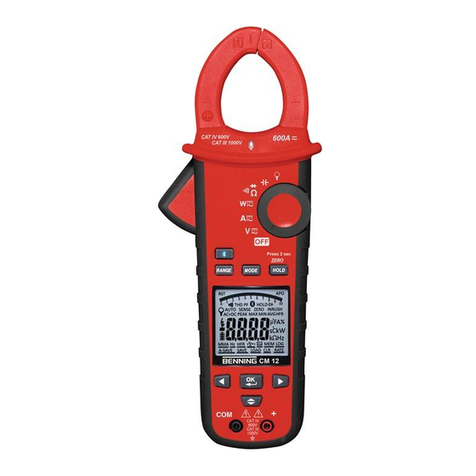
Benning
Benning CM 12 User manual
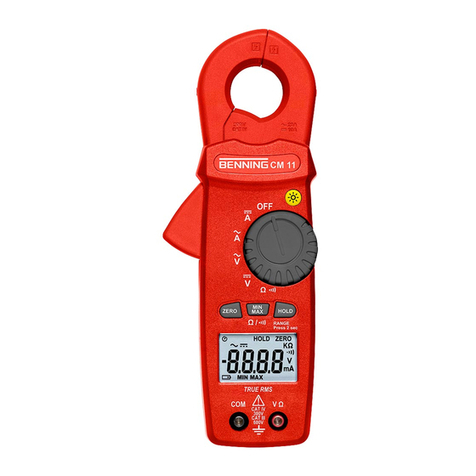
Benning
Benning CM11 User manual
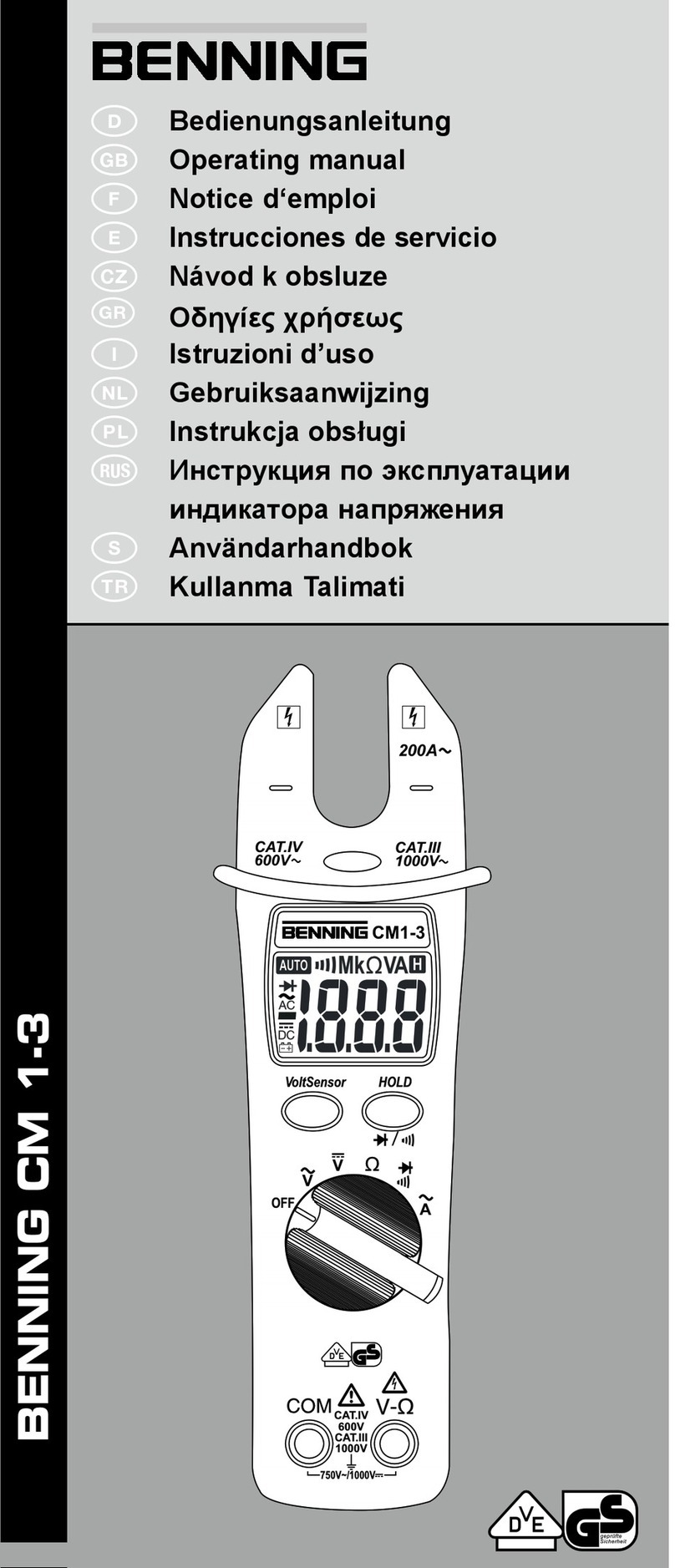
Benning
Benning CM 1.3 User manual
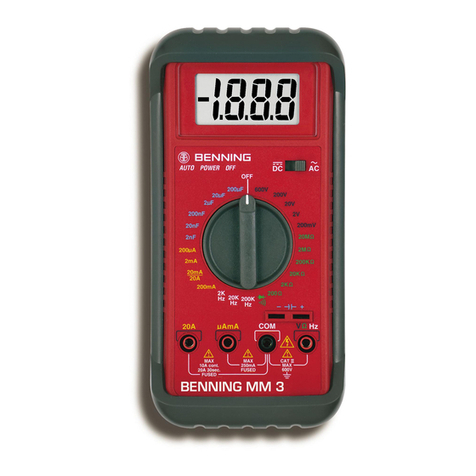
Benning
Benning MM 3 User manual
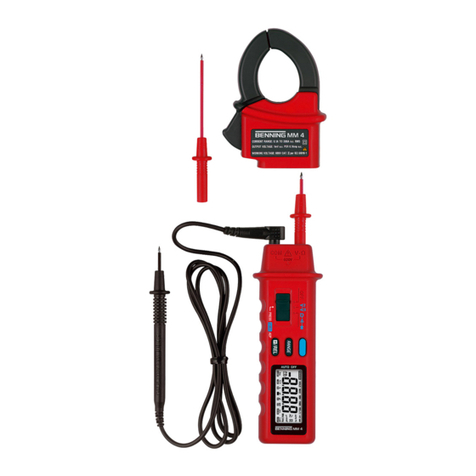
Benning
Benning BEMM4 User manual
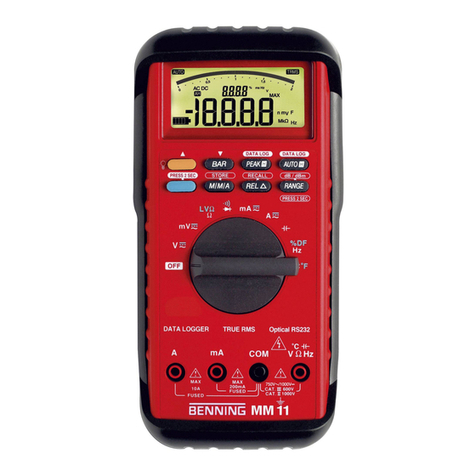
Benning
Benning MM 1-1 User manual

Benning
Benning MM 10-PV User manual
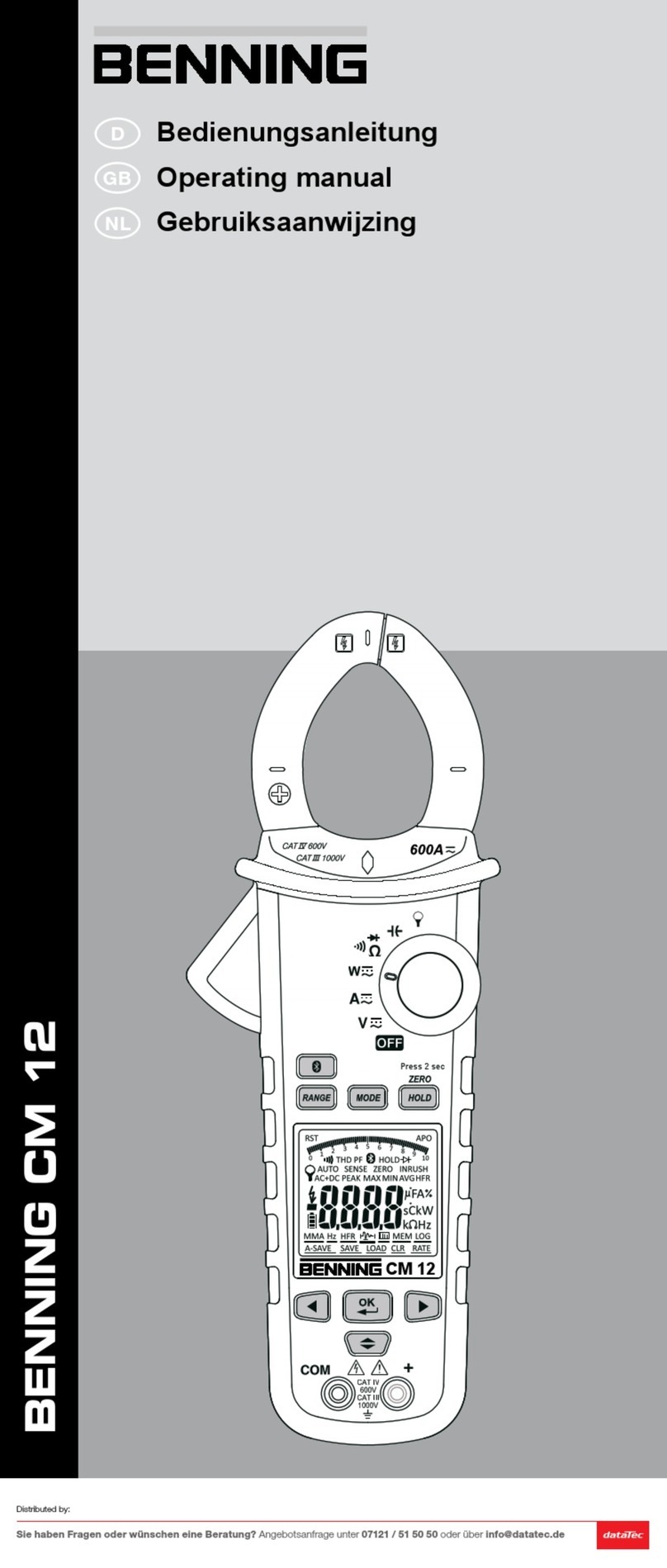
Benning
Benning 044680 User manual
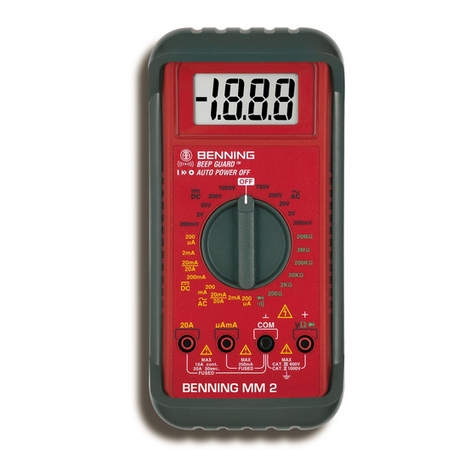
Benning
Benning MM 2 User manual
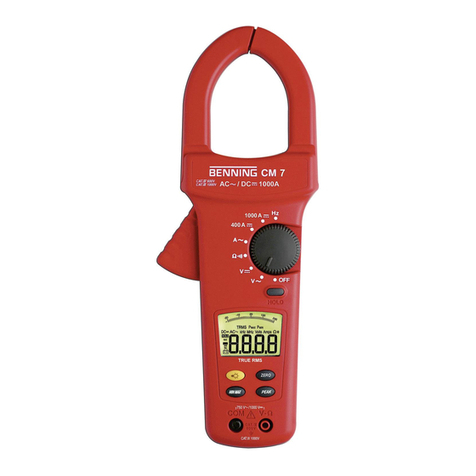
Benning
Benning CM 7 User manual

Benning
Benning MM P3 User manual
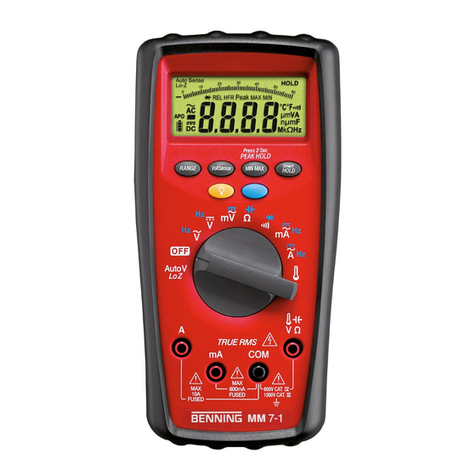
Benning
Benning MM 7-1 User manual
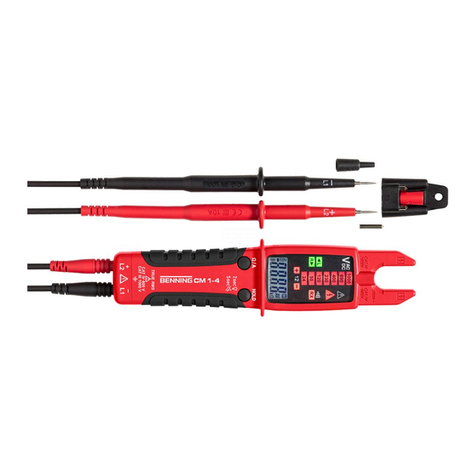
Benning
Benning CM 1-4 User manual

Benning
Benning MM 1-2 User manual

Benning
Benning MM 8 User manual
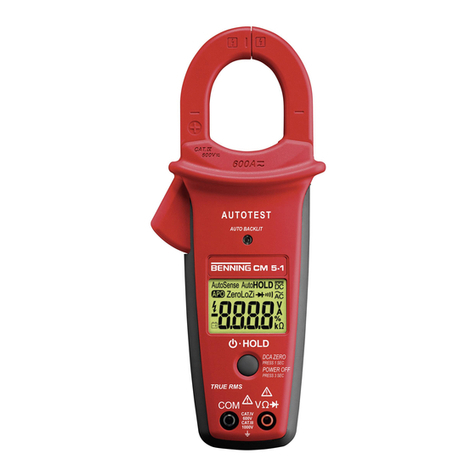
Benning
Benning CM 5-1 User manual
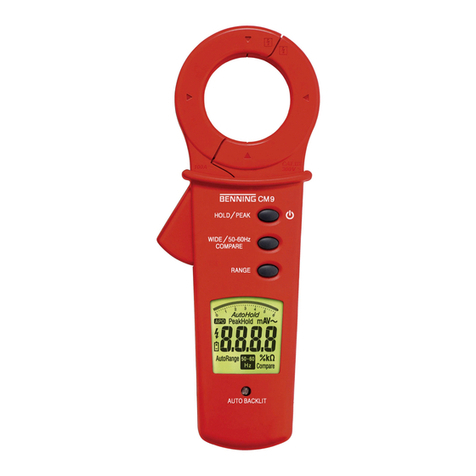
Benning
Benning CM 9 User manual
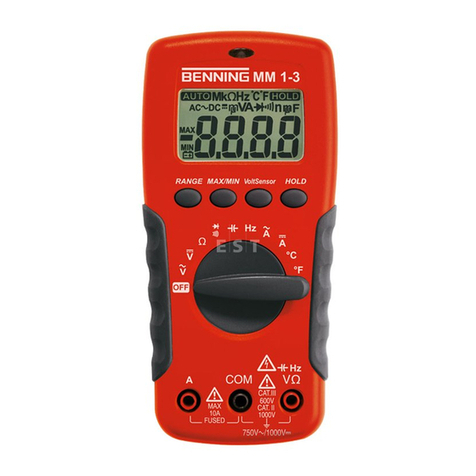
Benning
Benning MM 1-1 User manual
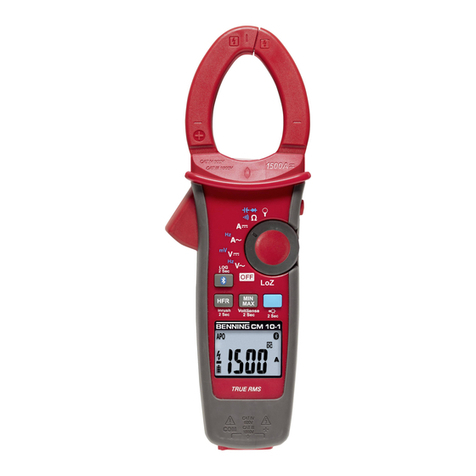
Benning
Benning CM 10-PV User manual
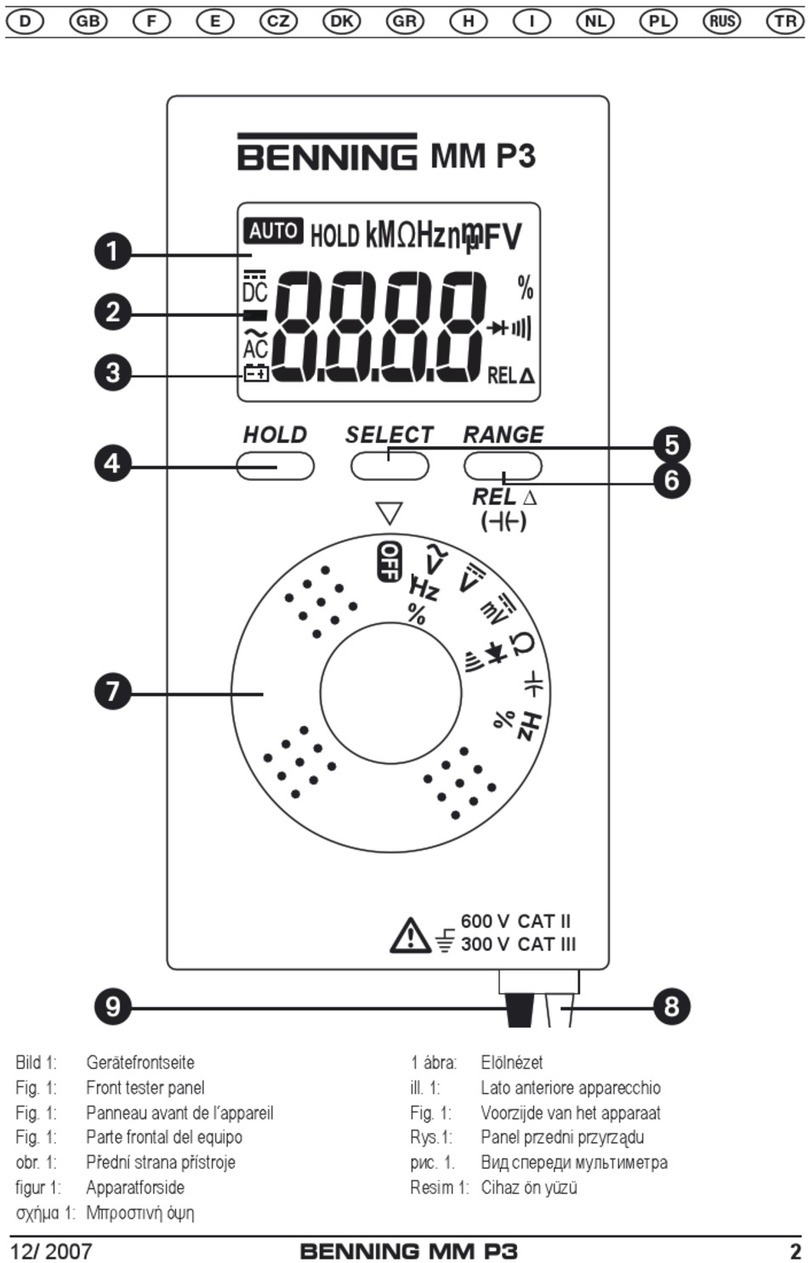
Benning
Benning MM P3 User manual
